On exhibit until Tuesday, March 19th, “Light and Form: Works by Ann Coddington and Jason Peot” at Parkland College’s Giertz Gallery is a two-person exhibition focused on two important art elements. The concept seems simple, but simple is effective here; both artists approach the concept differently. Ann Coddington, Associate Professor of Art at Eastern Illinois University, uses mixed media to create sculptural pieces about the body, memory, and nature. Her organic works range from ceramic birds on strings to amorphous heads made of woven reeds. Comparatively, Associate Professor of Art Jason Peot from Harper College in Palatine, IL, focuses on light and shadow to suggest space and time in sculpture. Together the pair make for an interesting juxtaposition, but flaws in the gallery space make it difficult to understand the context that brings these two artists together.
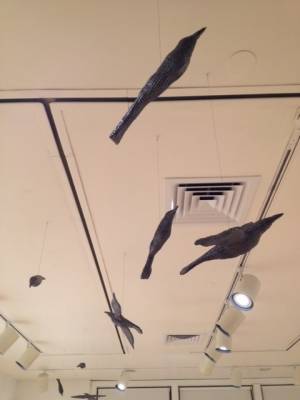 Even without context from an informative object label, Coddington’s pieces stand out to the visitor. Her “Taking Flight (small grouping)” — from 2016 of winged and wingless ceramic birds — plays beautifully with the graphite on paper rendering of birds in flight titled “flock” (2016). An additional image titled “Taking Flight diagram” (2014) suggests a proposal (or an actual, larger exhibition) of a larger grouping of ceramic birds taking flight. In looking closely at the birds, one can see the bumps and ridges of the woven twine used to create the model for the ceramic mold.
Even without context from an informative object label, Coddington’s pieces stand out to the visitor. Her “Taking Flight (small grouping)” — from 2016 of winged and wingless ceramic birds — plays beautifully with the graphite on paper rendering of birds in flight titled “flock” (2016). An additional image titled “Taking Flight diagram” (2014) suggests a proposal (or an actual, larger exhibition) of a larger grouping of ceramic birds taking flight. In looking closely at the birds, one can see the bumps and ridges of the woven twine used to create the model for the ceramic mold.
Weaving, a manual art that is both practical and decorative, is a common technique throughout Coddington’s works on display. Her piece, “heads” (2015), creates woven heads out of five distinct materials (dried plants, thin reeds, twine, sticks, and thinner twine). Similarly, “shadow/object” (2016) uses twined linen and random woven copper to suggest a shadow behind a reflective, egg-shaped object. This common thread of mixed media, technique, and natural forms gave some idea of the artist’s objectives in her artwork.
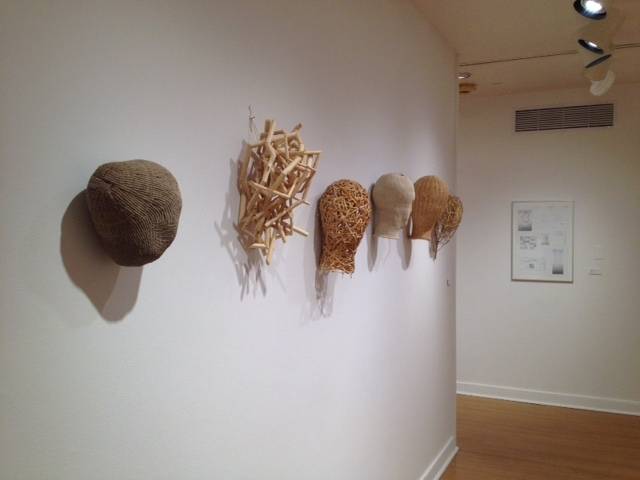
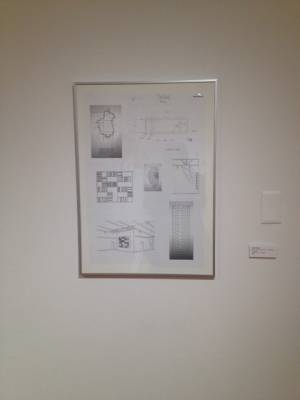 Focusing on light, Peot uses a variety of art forms to explore space and location. In his piece titled “Coordinates 1-5” (2011), the five archival digital prints show a composite of photographs taken of a sculptural object. Light streams out of the sculptural object in black and white contrast. What appears to be a reproduction of the original work, “Centers” (2016) shows the object Peot made and used for the “Coordinates” series of prints. Like Coddington, there is a separate artwork suggesting a proposal for a specific project related to Parkland. Titled “Prep-Composite #12 – Parkland College” (2016), a detailed reproduction shows a sculptural project. The size and position of the wood slats would relate to the number of people in each of the counties served by Parkland County. A focused light would then create a dense shadow that would convey “the population density of that county.”
Focusing on light, Peot uses a variety of art forms to explore space and location. In his piece titled “Coordinates 1-5” (2011), the five archival digital prints show a composite of photographs taken of a sculptural object. Light streams out of the sculptural object in black and white contrast. What appears to be a reproduction of the original work, “Centers” (2016) shows the object Peot made and used for the “Coordinates” series of prints. Like Coddington, there is a separate artwork suggesting a proposal for a specific project related to Parkland. Titled “Prep-Composite #12 – Parkland College” (2016), a detailed reproduction shows a sculptural project. The size and position of the wood slats would relate to the number of people in each of the counties served by Parkland County. A focused light would then create a dense shadow that would convey “the population density of that county.”
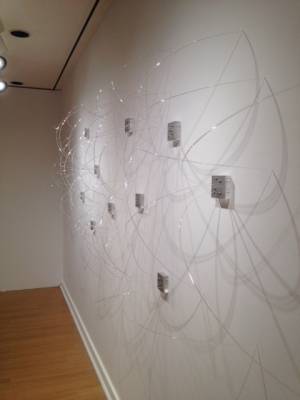 Whether or not this level of detail is conveyed in each work is difficult to determine without an explanatory label. “Common Drawing #2 (Il-IN)” with its bifurcated acrylic base and metal wire linking the two pieces easily conveys the idea of traveling back and forth across the states’ border. Similarly, “Base (25)” with generic pressed and numbered metal pieces that vaguely formed the bottom half the United States also seems to suggest travel between places. The numbers also suggest the chronological order of when the places were visited. Then you encounter “CATXNYFLILPAOHMGANC” (2009-2016) with its see-through acrylic wires sprouting out of the metal bases and imbedding their ends into the wall. The light creates a massive web of shadows that interact with the translucent but visible acrylic wires. Obviously, the work is referencing a multitude of locations and traveling, but without something explicit, it becomes incredibly ambiguous.
Whether or not this level of detail is conveyed in each work is difficult to determine without an explanatory label. “Common Drawing #2 (Il-IN)” with its bifurcated acrylic base and metal wire linking the two pieces easily conveys the idea of traveling back and forth across the states’ border. Similarly, “Base (25)” with generic pressed and numbered metal pieces that vaguely formed the bottom half the United States also seems to suggest travel between places. The numbers also suggest the chronological order of when the places were visited. Then you encounter “CATXNYFLILPAOHMGANC” (2009-2016) with its see-through acrylic wires sprouting out of the metal bases and imbedding their ends into the wall. The light creates a massive web of shadows that interact with the translucent but visible acrylic wires. Obviously, the work is referencing a multitude of locations and traveling, but without something explicit, it becomes incredibly ambiguous.
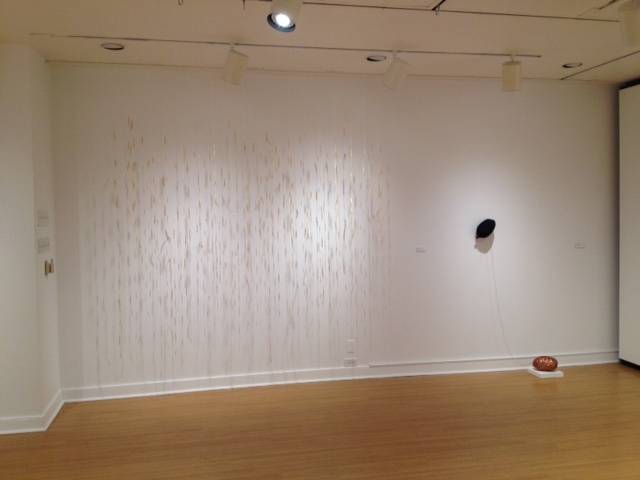
With its white walls and pale wood floors, the Giertz Gallery is a great space for exploring light and form. Yet the gallery space desperately needs to find a better way of providing information for visitors. A plastic binder with the artists’ statements and curriculum vitae shouldn’t be tucked away by the gallery attendant desk. It should be made available on one of the two benches for visitors to encounter. Ideally, an introductory didactic or handouts would be fantastic for a conceptual exhibit like “Light and Form.” However, didactics may not be the gallery’s aesthetic preference or part of their budget.
You can visit the Giertz Gallery in X Wing building, room 1 from Monday to Friday 10 a.m. to 7 p.m. and Saturday 12 p.m. to 2 p.m. For more information on the exhibition or the artists’ upcoming individual installations, visit the Current Exhibitions webpage for details.
About Sarah Keim:
Sarah Keim is a contributing writer to Smile Politely’s Arts section. She’s a bit of a recluse on social media, but you might bump into her out in the wilds of C-U. Frequent sightings occur at coffee shops, farmers markets, and hockey games.








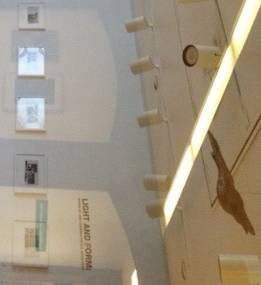
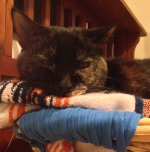 About Sarah Keim:
About Sarah Keim: